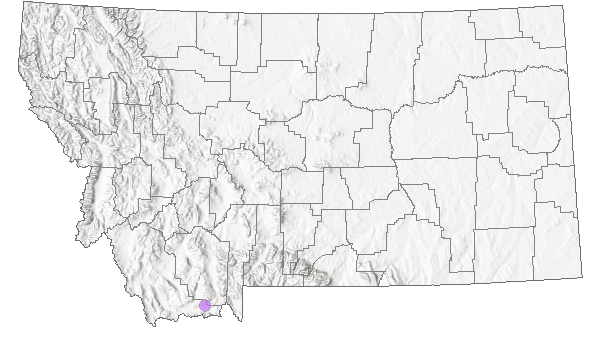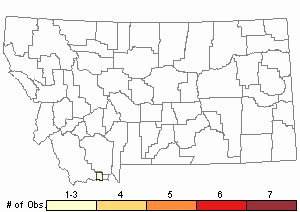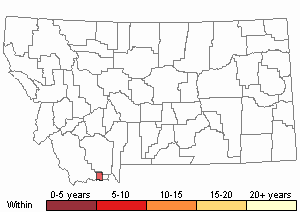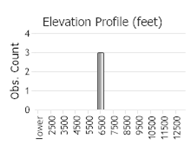View in other NatureServe Network Field Guides
NatureServe
Montana
Utah
Wyoming
Idaho
Wisconsin
British Columbia
South Carolina
Yukon
California
New York
St. Anthony Dune Tiger Beetle - Cicindela arenicola
State Rank Reason (see State Rank above)
Species is ranked S1S2 as a result of its global rarity and recently detected occupancy of isolated suitable habitat in the Centennial Sandhills of southwest Montana.
General Description
The following is taken from Rumpp (1967), Leffler (2001), and Pearson et al. (2015). Body length is 11-13 mm. Coppery-red to greenish-red above, the maculations broad, sometimes merging with each other and obscuring individual maculations, with dark base coloring reduced in extreme cases to a large wedge down the middle of the elytra and a small patch between the middle and last maculation. The anterior lateral portion of the thorax (propleuron) with brassy edges. Metallic greenish-blue below. Forehead, thorax, and legs hairy, labrum with a single tooth. Individuals from the St. Anthony Dunes, Idaho and Centennial Valley, Montana mostly with coppery-red (cupreous) elytra, those farther southwest (Minidoka area, Idaho) with mostly greenish elytra. Also known as the Idaho Dune(s) Tiger Beetle in some earlier literature (Logan 1995, and ISCE 1996).
Phenology
Tiger beetle life cycles fit two general categories based on adult activity periods. “Spring-fall” beetles emerge as adults in late summer and fall, then overwinter in burrows before emerging again in spring when mature and ready to mate and lay eggs. The life cycle may take 1-4 years. “Summer” beetles emerge as adults in early summer, then mate and lay eggs before dying. The life cycle may take 1-2 years, possibly longer depending on latitude and elevation (Kippenhan 1994, Knisley and Schultz 1997, Leonard and Bell 1999, Acorn 2001, and Pearson et al. 2015). Adult Cicindela arenicola, a spring-fall species, are active from early April to late July and again late August to late October or early November (Rumpp 1967, Bauer 1991, Larochelle and Larivière 2001, and Pearson et al. 2015). In Montana, adults noted from at least late May to early-September (Winton 2010, Winton et al. 2010, and Nate Kohler personal communication).
Diagnostic Characteristics
The following largely comes from Rumpp (1967), Leffler (2001), Winton (2010), and Pearson et al. (2015). Differs from the sympatric (in Montana, not Idaho)
Big Sand Tiger Beetle (
C. formosa) by smaller size, coppery-red to brownish-red elytra (rather than bright coppery-red), presence of greenish-blue highlights on the head and thorax lacking in
C. formosa, and metallic greenish-blue below rather than metallic bluish or purplish; the maculations of both tend to be broad and sometimes coalesced. Most similar to Bruneau Dunes Tiger Beetle (
C. waynei), which was once considered a greenish variant of
C. arenicola with a displaced mandibular tooth, but the ranges within Idaho do not overlap, and
C. waynei is not found in Montana.
Species Range
Montana Range
Range Descriptions

 Native
Native
Range Comments
Cicindela arenicola is patchily distributed in dune fields, largely along the Snake River Plain in ten counties of southeastern and south-central Idaho, between 2800 ft (853 m) and 5400 ft (1646 m) elevation (Rumpp 1967, Shook 1984, Logan 1995, ISCE 1996, Winton et al. 2010, and Pearson et al. 2015). A population in the Bruneau Dunes of Owyhee County in southwestern Idaho now treated as a separate species, Cicindela waynei (Rumpp 1967, ISCE 1996, Leffler 2001, and Pearson et al. 2015). The Montana population is restricted to the Centennial Valley of Beaverhead County and appears to be quite localized in distribution within the available sandhills; to 6720 ft (2048 m) elevation (Winton 2010, Winton and Ivie 2010, Winton et al. 2010, and Nate Kohler personal communication).
Observations in Montana Natural Heritage Program Database
Number of Observations: 3
(Click on the following maps and charts to see full sized version)
Map Help and Descriptions
Relative Density

Recency



 (Observations spanning multiple months or years are excluded from time charts)
(Observations spanning multiple months or years are excluded from time charts)
Migration
Non-migratory but capable of dispersal. Wings presumably fully developed (macropterous), it is a fast runner (Larochelle and Larivière 2001). Unlikely to disperse more than 0.75 miles (1.2 km) from natal dune (Logan 1995). However, haplotype of the Centennial Valley, Montana population indicates it is closely related to the nearest population in Idaho (Goldberg et al. 2012) occupying the St. Anthony Dunes about 64 km south, with the Continental Divide between the two localities (Hendricks and Lesica 2007, Winton et al. 2010).
Habitat
Adult and larval tiger beetle habitat essentially identical, the larvae live in soil burrows (Knisley and Schultz 1997). Across the range Cicindela arenicola largely restricted to sparsely vegetated sandy swales among dunes, open dune faces and tops, and blowouts that are well drained (Rumpp 1967, Bauer 1991, Logan 1995, Larochelle and Larivière 2001, and Pearson et al. 2015). Similar habitat in Montana, including sparsely vegetated sand dunes, sandy swales, blowouts, open loose sand associated with peaks of sandhills, sandy soils partially stabilized by sagebrush (Winton 2010, Winton et al. 2010, and Nate Kohler personal communication).
Food Habits
Larval and adult tiger beetles predaceous. In general, both feed considerably on ants (Wallis 1961, Knisley and Schultz 1997). Foods of Cicindela arenicola in the field not described but include ants, scavenged flies (bombyliids), probably various other small insects and spiders. Larvae in the field take mealworms (larval tenebrionid beetles) (Bauer 1991, Larochelle and Larivière 2001, and iNaturalist 2024).
Ecology
Larval tiger beetles live in burrows and molt through three instars to pupation, which also occurs in the larval burrow. Adults make shallow burrows in soil for overnight protection, deeper burrows for overwintering. Adults are sensitive to heat and light and are most active during sunny conditions. Excessive heat during midday on sunny days drives adults to seek shelter among vegetation or in burrows (Wallis 1961, and Knisley and Schultz 1997).
Cicindela arenicola has a narrow range of ecological tolerance (stenotopic). Larval burrows found in well-drained ground often in flattened, bowl-shaped and grassy portions of dune swales near slopes; burrows opened in spring, plugged in summer when ambient conditions are too warm, but are reopened in autumn. Larval burrows up to 42 cm deep; food-supplemented larvae in the field developed to 3rd instar in about 13 months while larvae lacking food-supplementation developed to 3rd instar in slightly over 2 years (Rumpp 1967, Bauer 1991, and Larochelle and Larivière 2001). Adults diurnal, active on sunny, warm days at 19-45°C, hiding on windy, cloudy or rainy days. Predators not described but probably include asilid (robber) flies. Escapes by running quickly; wary and difficult to approach. Associated tiger beetle species include
C. decemnotata,
C. formosa, and
C. tranquebarica (Rumpp 1967, Winton 2010, Winton et al. 2010, and Kohler and Martinka No date).
Reproductive Characteristics
Life cycle of Cicindela arenicola is 2-4 years, probably depending on annual precipitation and elevation, with 2nd and 3rd instar larvae and fall adults overwintering in burrows dug in sand. Fall adults emerge in April and May and mate, oviposition begins in April and extends through June then overwintering adults die, eggs hatch in 2-3 weeks, active larval burrows peak in May but rarely open July to mid-September then open again through October, pupation in August, fresh adults (tenerals) emerge August and September before overwintering (Bauer 1991, Larochelle and Larivière 2001, Pearson et al. 2015, and iNaturalist 2024). Little information on reproductive characteristics in Montana; both sexes and all three larval instars observed in the Centennial Valley during multiple visits from mid-June to early September, and from discovery in 2008 to at least 2016, indicating a reproducing population (Winton 2010, Winton et al. 2010, and Nate Kohler personal communication).
Management
Considered rare and of conservation concern throughout its range (ISCE 1996, Knisley et al. 2014, and Winton and Ivie No date); a Species of Concern in Montana. Sandy habitats favored by this species experience vegetation encroachment, especially from exotic and native grasses, resulting in dune stabilization as succession proceeds. This species will benefit from disturbance that retains early succession conditions. Other threats include off-road vehicle (ORV) use (seemingly not a problem for the Centennial Valley population), excessive livestock grazing, agricultural encroachment, and the potential for over-collecting (ISCE 1996, Knisley 2011, and Knisley et al. 2014). Dune stabilization is considered the greatest threat to the population in the Centennial Valley, Montana and for other sandy-habitat tiger beetle associates (Hendricks and Lesica 2007, and Winton 2010). Larval burrows could be impacted by trampling through livestock overgrazing (Bauer 1991) but grazing at appropriate stocking levels and duration could also be beneficial by keeping vegetation cover more open (simulating former bison activity). Appropriate use of limited controlled burns is another tool to maintain early succession conditions so long as a spatial mosaic of suitable microhabitats is maintained, and timing (mid to late autumn for controlled burns) does not overly impact late adult surface activity (Winton 2010, and Knisley 2011). Also, judicious use of herbicides may suppress vegetation encroachment and could be a valuable treatment tool for localized application to enhance habitat for this species (Bouffard et al. 2009).
Stewardship Responsibility
References
- Literature Cited AboveLegend:
 View Online Publication
View Online Publication Acorn, J. 2001. Tiger beetles of Alberta: killers on the clay, stalkers on the sand. The University of Alberta Press, Edmonton, Alberta. 120 p.
Acorn, J. 2001. Tiger beetles of Alberta: killers on the clay, stalkers on the sand. The University of Alberta Press, Edmonton, Alberta. 120 p. Bauer, K.L. 1991. Observations on the developmental biology of Cicindela arenicola Rumpp (Coleoptera: Cicindelidae). The Great Basin Naturalist 51(3):226-235.
Bauer, K.L. 1991. Observations on the developmental biology of Cicindela arenicola Rumpp (Coleoptera: Cicindelidae). The Great Basin Naturalist 51(3):226-235. Bouffard, S.H., K.V. Tindall, K. Fothergill. 2009. Herbicide treatment to restore St. Anthony dune tiger beetle habitat: a pilot study. Cicindela 41(1):13-24.
Bouffard, S.H., K.V. Tindall, K. Fothergill. 2009. Herbicide treatment to restore St. Anthony dune tiger beetle habitat: a pilot study. Cicindela 41(1):13-24. Goldberg, C. S., D. C. Tank, W. R. Bosworth, W. R. Bosworth, H. E. Marx, and L. P. Waits. 2012. Species designation of the Bruneau Dune tiger beetle (Cicindela waynei) is supported by phylogenetic analysis of mitochondrial DNA sequence data. Conservation Genetics 13 (2): 373-380.
Goldberg, C. S., D. C. Tank, W. R. Bosworth, W. R. Bosworth, H. E. Marx, and L. P. Waits. 2012. Species designation of the Bruneau Dune tiger beetle (Cicindela waynei) is supported by phylogenetic analysis of mitochondrial DNA sequence data. Conservation Genetics 13 (2): 373-380. Hendricks, P.D. and P. Lesica. 2007. A disjunct population of Cicindela formosa (Say) in southwestern Montana, U.S.A. (Coleoptera: Cicindelidae). Cicindela. 39:53-58.
Hendricks, P.D. and P. Lesica. 2007. A disjunct population of Cicindela formosa (Say) in southwestern Montana, U.S.A. (Coleoptera: Cicindelidae). Cicindela. 39:53-58. Idaho State Conservation Effort. 1996. Habitat conservation assessment and conservation strategy for the Idaho Dunes Tiger Beetle.Report No. 7. Boise, ID. 32 p.
Idaho State Conservation Effort. 1996. Habitat conservation assessment and conservation strategy for the Idaho Dunes Tiger Beetle.Report No. 7. Boise, ID. 32 p. iNaturalist. Research-grade Observations. Accessed 24 January 2024. https://www.inaturalist.org/
iNaturalist. Research-grade Observations. Accessed 24 January 2024. https://www.inaturalist.org/ Kippenhan, Michael G. 1994. The Tiger Beetles (Coleoptera: Cicindelidae) of Colorado. 1994. Transactions of the American Entomological Society 120(1):1-86.
Kippenhan, Michael G. 1994. The Tiger Beetles (Coleoptera: Cicindelidae) of Colorado. 1994. Transactions of the American Entomological Society 120(1):1-86. Knisley, C.B. 2011. Anthropogenic disturbances and rare tiger beetle habitats: benefits, risks, and implications for conservation. Terrestrial Arthropod Reviews 4:41-61.
Knisley, C.B. 2011. Anthropogenic disturbances and rare tiger beetle habitats: benefits, risks, and implications for conservation. Terrestrial Arthropod Reviews 4:41-61. Knisley, C.B., and T.D. Schultz. 1997. The biology of tiger beetles and a guide to the species of the south Atlantic states. Virginia Museum of Natural History Special Publication Number 5. 210 p.
Knisley, C.B., and T.D. Schultz. 1997. The biology of tiger beetles and a guide to the species of the south Atlantic states. Virginia Museum of Natural History Special Publication Number 5. 210 p. Knisley, C.B., M. Kippenhan, and D. Brzoska. 2014. Conservation status of United States tiger beetles. Terrestrial Arthropod Reviews 7:93-145.
Knisley, C.B., M. Kippenhan, and D. Brzoska. 2014. Conservation status of United States tiger beetles. Terrestrial Arthropod Reviews 7:93-145. Kohler, N. and B. Martinka. 2016. Centennial Valley Cicindelinae survey, September 9-10. 9 p.
Kohler, N. and B. Martinka. 2016. Centennial Valley Cicindelinae survey, September 9-10. 9 p. Kohler, Nathan S. Excel spreadsheets of tiger beetle observations. 6 August 2022.
Kohler, Nathan S. Excel spreadsheets of tiger beetle observations. 6 August 2022. Larochelle, A and M Lariviere. 2001. Natural history of the tiger beetles of North America north of Mexico. Cicindela. 33:41-162.
Larochelle, A and M Lariviere. 2001. Natural history of the tiger beetles of North America north of Mexico. Cicindela. 33:41-162. Leffler, Stanford, 2001. A new species of tiger beetle from southwestern Idaho (Coleoptera: Cicindelidae). Cicindela 33(1-2): 19-33.
Leffler, Stanford, 2001. A new species of tiger beetle from southwestern Idaho (Coleoptera: Cicindelidae). Cicindela 33(1-2): 19-33. Leonard, Jonathan G. and Ross T. Bell, 1999. Northeastern Tiger Beetles: a field guide to tiger beetles of New England and eastern Canada. Boca Raton, FL: CRC Press. 176 p.
Leonard, Jonathan G. and Ross T. Bell, 1999. Northeastern Tiger Beetles: a field guide to tiger beetles of New England and eastern Canada. Boca Raton, FL: CRC Press. 176 p. Logan, D.R 1995. Idaho Dunes Tiger Beetle survey 1995: Cicindela aremcola Rumpp. Idaho Bureau ofLand management Technical Bulletin No. 95- 1 7. 1 8 p. + appendices.
Logan, D.R 1995. Idaho Dunes Tiger Beetle survey 1995: Cicindela aremcola Rumpp. Idaho Bureau ofLand management Technical Bulletin No. 95- 1 7. 1 8 p. + appendices. Pearson, D.L., C.B. Knisley, and C.J. Kazilek. 2006. A field guide to the tiger beetles of the United States and Canada: identification, natural history, and distribution of the Cicindelidae. Oxford University Press, New York, New York. 227 pp.
Pearson, D.L., C.B. Knisley, and C.J. Kazilek. 2006. A field guide to the tiger beetles of the United States and Canada: identification, natural history, and distribution of the Cicindelidae. Oxford University Press, New York, New York. 227 pp. Pearson, D.L., C.B. Knisley, D.P. Duran, and C.J. Kazilek. 2015. A field guide to the tiger beetles of the United States and Canada, second edition. New York, NY: Oxford University Press. 251 p.
Pearson, D.L., C.B. Knisley, D.P. Duran, and C.J. Kazilek. 2015. A field guide to the tiger beetles of the United States and Canada, second edition. New York, NY: Oxford University Press. 251 p. Rumpp, N. L. 1967. A new species of Cicindela from Idaho (Coleoptera: Cicindelidae). Proceedings of the California Academy of Sciences 35:129-140.
Rumpp, N. L. 1967. A new species of Cicindela from Idaho (Coleoptera: Cicindelidae). Proceedings of the California Academy of Sciences 35:129-140. Shook, G.A. 1984. Checklist of tiger beetles from Idaho (Coleoptera: Cicindelidae). Great Basin Naturalist 44(1):159-160.
Shook, G.A. 1984. Checklist of tiger beetles from Idaho (Coleoptera: Cicindelidae). Great Basin Naturalist 44(1):159-160. Wallis, J.B. 1961. The Cicindelidae of Canada. Toronto, Ontario, Canada: University of Toronto Press. 74 p.
Wallis, J.B. 1961. The Cicindelidae of Canada. Toronto, Ontario, Canada: University of Toronto Press. 74 p. Winton, R. C., M. G. Kippenham, and M. A. Ivie. 2010. New state record for Cicindela arenicola Rumpp (Coleoptera: Carabidae: Cicindelinae) in southwestern Montana. The Coleopterists Bulletin 64(1):43-44.
Winton, R. C., M. G. Kippenham, and M. A. Ivie. 2010. New state record for Cicindela arenicola Rumpp (Coleoptera: Carabidae: Cicindelinae) in southwestern Montana. The Coleopterists Bulletin 64(1):43-44. Winton, R.C. 2010. The effects of succession and disturbance on Coleopteran abundance and diversity in the Centennial Sandhills. M.Sc. Thesis. Montana State University. Bozeman, MT. 77pp + Appendices.
Winton, R.C. 2010. The effects of succession and disturbance on Coleopteran abundance and diversity in the Centennial Sandhills. M.Sc. Thesis. Montana State University. Bozeman, MT. 77pp + Appendices. Winton, Ross C. and Michael Ivie. 2010. A Report on a New Montana Record of Sensitive Tiger Beetle St. Anthony Sand Dune Tiger Beetle (Cicindela arenicola Rumpp). 4 pp.
Winton, Ross C. and Michael Ivie. 2010. A Report on a New Montana Record of Sensitive Tiger Beetle St. Anthony Sand Dune Tiger Beetle (Cicindela arenicola Rumpp). 4 pp.
- Additional ReferencesLegend:
 View Online Publication
View Online Publication
Do you know of a citation we're missing? Bousquet, Yves. 2012. Catalogue of Geadephaga (Coleoptera; Adephaga) of America north of Mexico. ZooKeys. 245:1-1722.
Bousquet, Yves. 2012. Catalogue of Geadephaga (Coleoptera; Adephaga) of America north of Mexico. ZooKeys. 245:1-1722.
- Web Search Engines for Articles on "St. Anthony Dune Tiger Beetle"
- Additional Sources of Information Related to "Insects"





